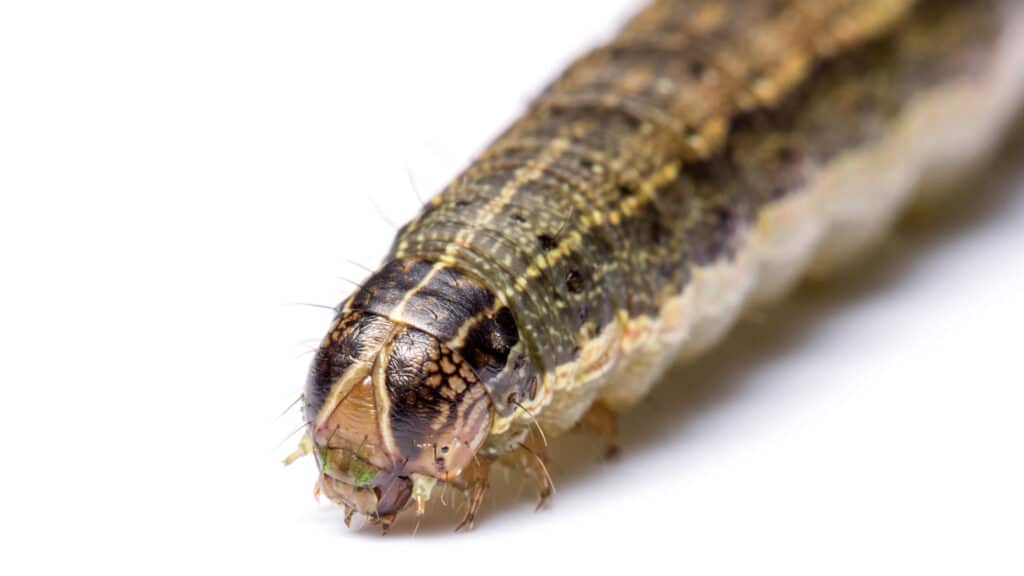Perfume Component Helps Lure Male Moth Pests
North Carolina State University researchers have shown that adding a small amount of a chemical used in perfumes – nonanal – to a two-chemical combination of other sex pheromones helped increase the cocktail’s effectiveness in mimicking female fall armyworm “come hither” calls to males.
The findings could eventually help farmers better detect, monitor and control fall armyworm populations, which negatively affect some 350 plant species – including crops like corn and cotton as well as turfgrass and other cultivated grasses.
“Nonanal is emitted by people, birds and even apples,” said Coby Schal, Blanton J. Whitmire Distinguished Professor of Entomology and co-corresponding author of a paper describing the research. “It is a universal attractant that, by itself, doesn’t have much of an effect. But when a certain percentage of nonanal is added to the multi-chemical attractant mixture discovered nearly 40 years ago, it has a highly stimulatory effect – in this case attracting male fall armyworm moths in the lab and then attracting male moths to traps in field experiments.”
Fall armyworms are found mostly in warmer climates; after originating in South America they spread to North America and then to sub-Saharan Africa, the Middle East, the Indian subcontinent, China, and, most recently, Australia. Arguably one of the world’s most devastating pests, fall armyworm caterpillars can rapidly chew through crops and lawns.
The researchers started examining ways to attract and then trap male moths as part of a “mating disruption” strategy.
“When you see fall armyworm moths you know that – two weeks later – you’re going to have caterpillars,” Schal said. “So controlling the early flying adults is key. Mating disruption is the way to go when using pheromones, as males will find traps rather than females. Pests have been eliminated from wide areas using several approaches including mating disruption – like pink bollworm, a major cotton pest in the Southwest.” Other uses of the pheromone include detection of the fall armyworm in areas not yet invaded by this pest and lure-and-kill, where the pheromone attracts the fall armyworm to an insecticide or a pathogen.

The researchers used gas chromatography, in which chemical compounds are separated in a controllable oven, to test whether the fall armyworm males would respond to other chemicals besides the known blend of chemicals. By connecting this instrument to the antennae of fall armyworm males and monitoring their electrical activity, the researchers saw that nonanal stimulated male fall armyworms.
The researchers then tested the blend with nonanal in other lab tests. Males were somewhat attracted to the traditional pheromone blend, but adding the “right amount” of nonanal to the blend greatly increased the response. The right amount turned out to be about 1% percent of the total blend, as adding too little nonanal increased the response over the traditional blend, but not by much.
Finally, the researchers used bait-and-trap experiments on NC State cotton and sorghum research fields in Raleigh and Clayton, where they tried to use different pheromone blends to capture male moths. There, they showed that nonanal by itself had no effect on males. Higher doses of nonanal in the traditional blend – at 2% and 4% concentrations – reduced the compound’s effectiveness. Again, 1% nonanal in the blend emerged as the most effective, capturing more males.
Interestingly, the shape of the trapping device also affected the success rates in capturing males. Cone-shaped traps did not perform as well as bucket-shaped traps.
The field studies also showed few other insect species – or female fall armyworms – trapped.
“We have tweaked this system to make it highly species-specific, which is especially important in places where similar moth species live,” Schal said.
The researchers filed a patent on the discovery and have exclusive licensing agreements with industry partners that will further test nonanal’s effectiveness when added to the traditional pheromone blend.
The study appears in Pest Management Science. Ahmed M. Saveer, Eduardo Hatano and Ayako Wada-Katsumata from NC State co-authored the paper, as did Robert L. Meagher from the USDA’s Agricultural Research Service. Funding was provided by a N.C. Biotechnology Center Flash Grant (2020-FLG-3809), by the USDA Southern IPM Center (2021-1645), by the U.S. National Science Foundation (NSF IOS1456973) and by the Blanton J. Whitmire Endowment at NC State.
-kulikowski-
Note to editors: The abstract of the paper follows.
“Nonanal, a new fall armyworm sex pheromone component, significantly increases the efficacy of pheromone lures”
Authors: Ahmed M. Saveer, Eduardo Hatano, Ayako Wada-Katsumata and Coby Schal, North Carolina State University; Robert L. Meagher, USDA Agricultural Research Service
Published: March 19, 2023 in Pest Management Science
DOI: 10.1002/ps.7460
Abstract:
Background: The fall armyworm (FAW), Spodoptera frugiperda (J.E. Smith), is a global pest that feeds on >350 plant species and severely limits production of cultivated grasses, vegetable crops and cotton. An efficient way to detect new invasions at early stages, and monitor and quantify the status of established infestations of this pest is to deploy traps baited with species-specific synthetic sex pheromone lures.
Results: We re-examined the compounds in the sex pheromone glands of FAW females by gas chromatography-electroantennogram detector (GC-EAD), GC–mass spectrometry (MS), behavioral and field assays. A new bioactive compound from pheromone gland extracts was detected in low amounts (1% relative to (Z)-9-tetradecenyl acetate (Z9-14:OAc), the main pheromone component), and identified as nonanal. This aldehyde significantly increased attraction of male moths to a mix of Z9-14:OAc and (Z)-7-dodecenyl acetate in olfactometer assays. Adding nonanal to this two-component mix also doubled male trap catches relative to the two-component mix alone in cotton fields, whereas nonanal alone did not attract any moths. The addition of nonanal to each of three commercial pheromone lures also increased male catches by 53–135% in sorghum and cotton fields.
Conclusion: The addition of nonanal to pheromone lures should improve surveillance, monitoring and control of FAW populations.
This post was originally published in NC State News.
- Categories:


